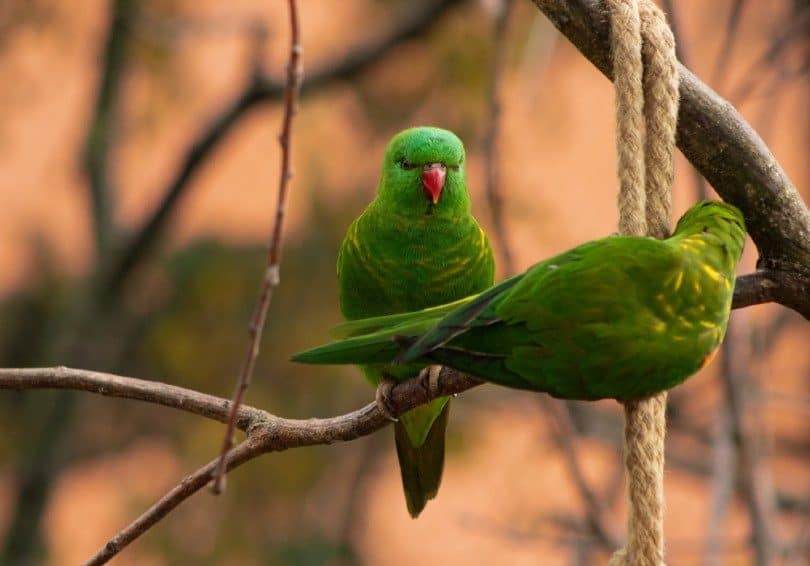Though not quite as common as the Peach-faced Lovebird or the Masked Lovebird varieties, this handsome lovebird has a very pleasant disposition. They are more tolerant of other lovebirds if they all have sufficient space, and are one of the least noisy species
Being from a high mountainous area, the Abyssinian Lovebird can tolerate an outdoor aviary environment as long as they are kept out of drafts and the temperatures are not overly extreme. They are relatively hardy birds, similar to the Fischer’s Lovebird or the Masked Lovebird, but not quite as hardy as the Peach-faced Lovebirds.
Typical of all the lovebirds, the Abyssinian Lovebird is very social and loves companionship. Their natural behavior is to live closely with a companion so are often kept with another lovebird. Though they make a very fine and affectionate pet when hand-raised, they will need a lot of attention if kept singly. Most are kept in pairs to satisfy their considerable need for constant companionship, mutual preening, and socialization.
- For more information and the care of Lovebirds see: Guide to a Happy, Healthy Lovebird
Scientific Classification
| Kingdom: | Animalia |
| Phylum: | Chordata |
| Class: | Aves |
| Order: | Psittaciformes |
| Family: | Psittacidae |
| Genus: | Agapornis |
| Species: | taranta |
Scientific Name
Agapornis taranta
Lovesbirds, There are two subspecies of the Abyssinian Lovebird or Black-Winged Lovebird; Agapornis taranta tarana and Agapornis taranta nana. The latter species is a bit smaller and has a more intense coloration. It also has a smaller bill and shorter wings.
Distribution
The Abyssinian Lovebird or Black-Winged Lovebird is native to mountainous areas and is adapted to cooler weather. From Africa, they are found in southern Eritrea and the southwestern highlands of Ethiopia.
Description
The Abyssinian Lovebird has a general green plumage, though a shade lighter on the head, rump, just above the tail, and the underside.
They are sexually dimorphic lovebirds, meaning the male and female are clearly different in outward appearance. Males have bright red feathers on the forehead and narrowly circling the eye, they also have brown to black outer flight feathers, even as babies. The females head has no red and the wing feathers are green while babies, developing brownish-black wing feathers like the males, as they mature.
Females are also a bit heavier, reaching about 1.9 oz (53 grams) while males can reach about 1.6 oz (44 grams).
Size – Weight
The Abyssinian Lovebird is one of the largest lovebirds reaching up to 6 – 6 1/2″ (15 – 16.5 cm) in length, with the female being the larger of the pair. (Of the two subspecies, Agapornis a. nana is a bit smaller than Agapornis a. tarana)
Care and feeding
A roomy cage is required as lovebirds are very active. If you have a tame pet that is kept in a small cage, it needs to be let out for extended periods to fly about.
In the wild the Abyssinian Lovebird eats seeds, berries, and fruits with some favorites being the fruit of the sycamore fig as well as juniper berries. As a pet they will enjoy a variety of seeds, fruits, vegetables, and commercial pellets. They do require a higher fat content in their diet than other lovebirds, which you can provided with additional sunflower seeds.
- See About Lovebirds: Housing and About Lovebirds: Care and Feeding for more information.
Social Behaviors
In the wild the Abyssinian Lovebirds are seen in small flocks of 4 to 20 birds. They have been the least likely of the lovebirds to be attracted to people and areas of human habitation.
A lovebird is a very social bird with its companion, and it is generally thought to be essential for their good health and happiness that they be kept in pairs rather than singly. They can, however, be aggressive towards other birds in an aviary setting. The Abyssinian Lovebird has been found to be one of the most tolerant as long as there is plenty of space for all.
Activities
Loves to fly, climb, and play. Provide lots of room and lots of toys.
Breeding/Reproduction
The Abyssinian Lovebird is a rather unpredictable breeder, with some pairs being quite prolific while others will go for years without mating. These birds will, however, only breed as single pairs. They cannot be bred in colonies. Though not as common in captivity as other lovebirds, there has been successful breeding as well as the development of some color mutations.
In the wild these birds nest in the holes of trees and inhabit the same year round for roosting. They are not avid nest builders, so when you provide them with a nest box be sure to put a thick layer of moist wood shavings on the bottom. The nest box will need to have inside dimensions of 10″ long x 6″ deep x 7″ high (25 x 15 1/2 x 18 cm).
The hen will lay three to six eggs which are incubated for about 24-26 days. The young fledge (leave the nest) in about 3 to 3 /12 weeks but will still be dependent until about 4 weeks of age. When they become independent, it is best to remove the young to their own housing.
See About Lovebirds: Breeding/Reproduction for more information on breeding.
Potential Problems
This bird has a less shrill call than that of other lovebirds, though it will call out in the middle of the night if it gets upset. Lovebirds in general can be rather noisy for parts of the day.
See About Lovebirds: Potential Problems for information on illnesses.
Availability
The Abyssinian Lovebird is not as common as other varieties of lovebirds, but is occasionally available.
Featured Image Credit: Martin Kominko, Shutterstock
